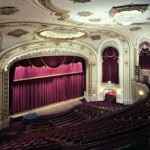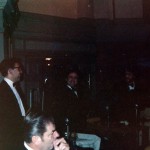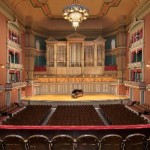My Musical Career | Part Fifteen
The Albany Years – Part One
I lived and worked in the Albany, New York area for three seasons, from October, 1977 until September 1, 1980. During this period I served as timpanist of the Albany Symphony Orchestra and additionally with the Berkshire Symphony Orchestra in Williamstown, Massachusetts. Both orchestras were conducted by Julius Hegyi, and I made a good enough impression on him at my initial Albany audition for him to offer me the engagement with the Berkshire Symphony, which was the orchestra associated with Williams College, as well.
As I mentioned earlier, I started out my Albany period living in what amounted to a boardinghouse at 137 New Scotland Avenue. This was located close to the Albany Medical Center and not far from Washington Park. It was a matter of a two block walk to catch the busses of the Capital District Transportation Authority, so public transportation was not a problem.
Living Conditions
My room was not too bad. I had enough space to settle in and organize myself, and I had a phone installed. However, I had to share washroom facilities, and I had to eat out as there was no stove or fridge. I didn’t mind that too much as the superintendent, Earl Stoddard, kept the building clean. I had a woman neighbor who hung out her laundry in the shared bathroom to dry, and I remember many was the time that I had to move her stockings and underwear in order to get at the sink. That did get a little old.
For eating, there was a mom-and-pop style diner that served breakfast and lunch, and a deli that stayed open in the evenings, so I was always able to get food, although a lot of money went out that I could have used for saving!
I lived in that room from October 1977 until March, 1978 when I moved to an apartment at 540 Madison Avenue, right across from Washington Park and about three and a half blocks from my old boarding house. I shared the apartment with Ed Eckersdorff and two medical students, and had my own large room as well as bathroom and kitchen privileges. The building was owned by a member of the Albany Symphony, a violinist by the name of Judy Goberman and her husband, Mike Linehan. I had met Judy at the very first rehearsal that I attended as a member of the orchestra. She was in her early forties at the time, and was the daughter of a well-respected New York City orchestra conductor/arranger named Max Goberman. In the course of conversation, she asked me where I was living, and I told her about the boardinghouse on New Scotland Avenue. She must have been privately appalled, because she told me that one of the med students that rented a room in the flat at the top floor of her brownstone on Madison Ave was leaving at the end of February, and would I consider moving in and taking his place?
That is how I left that boardinghouse, and it was none too soon.
A few months after I moved to the apartment at Madison Avenue, the boardinghouse caught fire and burned. I went by it on several occasions after the fire, and gave thanks to the Good Lord for sparing me from disaster.
The Albany Symphony Orchestra
The Albany Symphony was founded in 1930 by Professor John Carabella, and had up to the point where I joined it a rather distinguished history under such conductors as Rudolph Thomas, Ole Windingstad, Edgar Curtis, and from 1966, Julius Hegyi.The orchestra in 1977 had about 80 or so members, and it was an excellent group, and it did not take me long to get to know many of the musicians and become close colleagues with many of them.
Julius Hegyi was in the eleventh year of his music directorship at this time, and was quite a learned and eloquent musician; a graduate of Julliard, he was a violinist of more than ordinary talent, and his conducting skills were formidable. He came to the orchestra after a successful ten-year career as music director of the Chattanooga Symphony Orchestra.
The musicians
As I said earlier, the orchestra was made up at the time of about 80 musicians – college and high school teachers; young professional musicians like myself starting out on their careers; and housewives who were also fine musicians. They were an excellent group of musicians and it was an honor to be among their number. The concertmaster was an excellent violinist named Leo Mahigian. He was about fifty or so at the time I joined the orchestra, and was very down-to-earth. He was very helpful to me in getting me acclimated, and was a fine soloist and leader. Janet Rowe, the wife of principal trombonist Richard Rowe, was assistant concertmaster. She was also an excellent violinist, and she and Leo made an excellent first stand combination. Mary Lou Saeta was the principal second violin, and led her section very well. She was very direct and down-to-earth and told things like they were. Susan St. Amour was principal viola at the time, and of this writing is still a member of the orchestra. Principal cellist was Douglas Moore, who doubled as head of the music department at Williams College. He left the orchestra after my second season to devote his time to his family and his expanding duties at the college. He was an excellent player and a gentleman. Martha Rauhrbaugh took his place during my third and last season. Dave Cobb was principal bass for my first two seasons. I owed my positions in both the Albany Symphony and the Vermont Symphony to his recommendation and will be always be grateful to him for his advocacy. He left the orchestra just before my last season due to family issues and a desire to relocate. He re-married a violist in the Vermont Symphony, Mary Van Citters and settled in Massachusetts, having inherited a cranberry bog. From what I heard, he enjoyed a fruitful second career as a cranberry farmer.
His son Tim, who later served for many years as principal bass of the Metropolitan Opera and now has that position with the New York Philharmonic succeeded him as principal. Our principal harpist was Marjorie Hartzell, who also served as harpist for the Lake George Opera. She was superb. Principal Oboe was Randall Ellis, who was just fantastic. I remember loving his sound. Nat Fossner was English horn, and he was also superb. Irv Gilman was principal flute; Sue Hohenberg (as she was then) was the excellent principal clarinetist; I believe she is still with the orchestra. June Partch was principal bassoon, and Stephen Walt, the son of the Boston Symphony’s Sherman Walt, was second bassoon. Bill Zembery was principal horn during my first season; Ron Patrick was third horn; James Morris was our excellent first trumpet; Don Boucher was second trumpet. Dick Rowe was principal trombone. H. Luther Everly was our excellent tuba player. During a rehearsal, I asked him what the H stood for. He answered “Horace.” I asked him if anybody kidded him about it. He calmly stood up and unfolded to his 6 foot 8 inch height and quietly said “Not really. I was already six foot four when I was in high school.” He was a really nice fellow.
Musical Memories
I have a lot of musical memories from those days. The orchestra members were very welcoming and helpful, and the percussion section (even with all the changes) got along very well. Barry was the humorous one. He liked to pop surprises on people, particular during performances. For example, during our New Year’s Concert program – which featured John Williams’ Star Wars Suite – Barry donned a Darth Vader mask while playing cymbals. Maestro Hegyi walked out onstage to start the program, took one look at Barry and walked off the stage, almost laughing out loud. Barry played the whole first movement like that and confessed that after the opening cymbal stroke, he doubted that he played one correct note that whole movement.
During a youth concert, which featured Copland’s “Hoe-Down” from”Rodeo”, Barry and Joe did a “do-sie-do” right in the middle of it – being very careful to time it so that they made their entries on time. Both had cowboy hats on their heads.
So you can see that it was a lively bunch of people with whom I was now associated, as well as a very good group.
That first season was spectacular. The orchestra played in two venues. The main venue was Albany’s Place Theater, a 1920’s picture palace located at 19 Clinton Avenue. I already referred to this hall in my previous post. The other venue was a concert hall located on the top of an old bank in Troy, which was located to the north and east of the Hudson from Albany. The bank was the Troy Savings Bank, and the
The orchestra played all five concerts at the Palace Theater, and repeated three of them at the Music Hall in Troy. Our opening concert series, if I remember correctly, was played in both venues. The main work was Richard Strauss’ “Also Sprach Zarathusthra”. The orchestra was still using the old Ludwigs – the set in which the 28 inch drum was totally out of round. I managed to play the opening triplet solos on the 25 and 30 inch drums, and that sounded acceptable. I sure wish we had waited until the Hinger drums arrived later in the season. The high points of that first season included a concert at the Palace Theater, in which we played a really fine program. It started with the orchestral version of Rachmaninov’s “Vocalise”; this was followed by a performance of Beethoven’s “Choral Fantasy” for piano, chorus and orchestra. Charles Joseph was the piano soloist, and we were joined by the Capitol Hill Choral Society, who also joined us for the final work – Carl Orff’s epic “Carmina Burana”. I really got my teeth into that one, despite the poor quality of the timpani.
That season was a blockbuster: we performed Beethoven’s Eighth Symphony; Bartok’s Concerto for Orchestra; Elgar’s “Enigma Variations”, and Tchaikovsky’s “Pathetique” Symphony. This was before the Hinger drums arrived.
I apparently made a good impression with both Julius Hegyi and the musicians, because after that first concert series, the maestro asked me to become part of his orchestra at Williams College in Williamstown, Massachusetts, in addition to my duties with the orchestra. The very first concert I played with them, in the fall of 1977 proved to be a baptism of fire, which I came out of with honor. I’ll relate that in the next edition of this blog.




Recent Comments